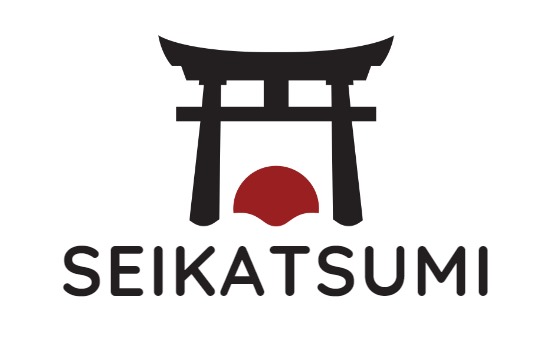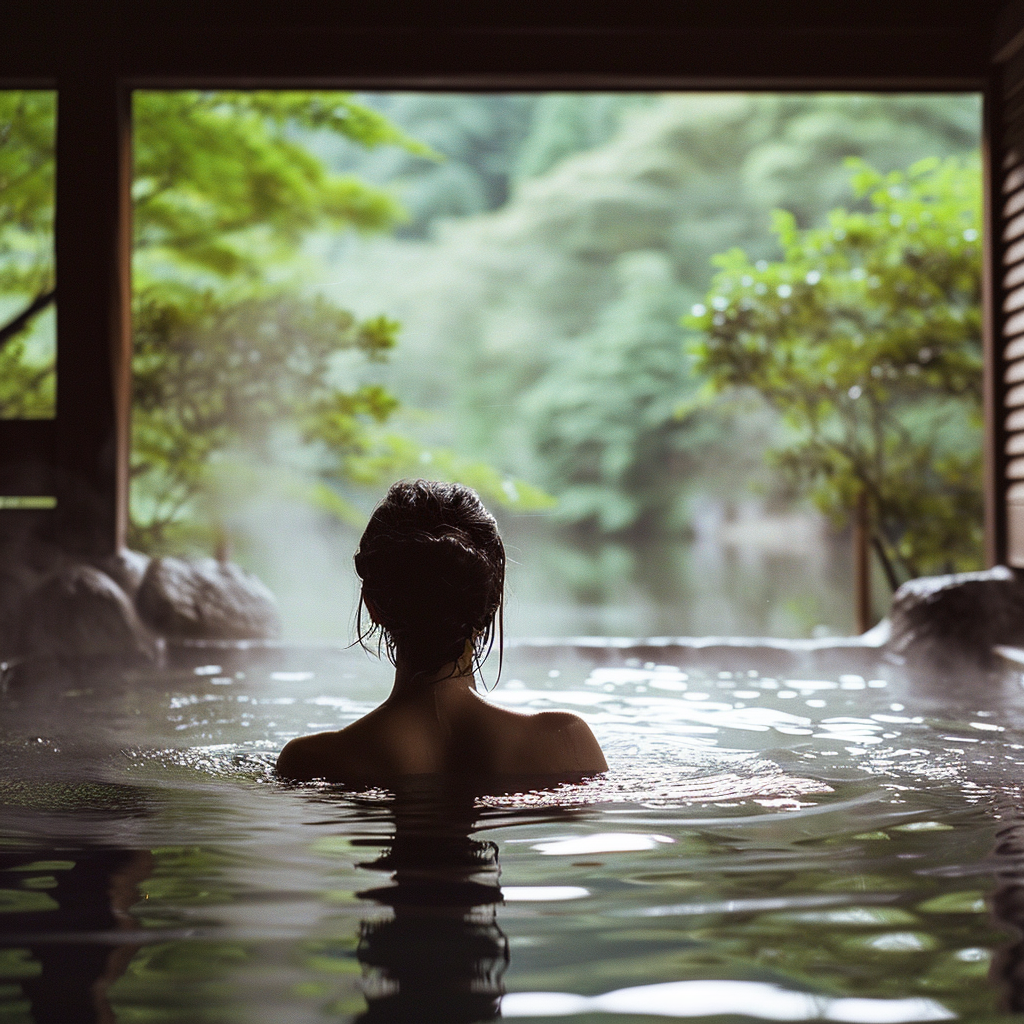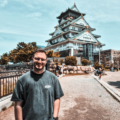As an enthusiast of relaxation and cultural experiences, I find Japanese hot springs, known as “onsen,” to be a fascinating world to explore.
Having dipped in multiple onsen across Japan, I’ve realized there’s something special about the serene atmosphere that surrounds these geothermal wonders.
Immerse yourself in the world of japanese hot springs and join me on a magical journey!
Japanese Hot Springs Origins and Traditions
I’ve always found the allure of Japanese Hot Springs/Onsen to be deeply fascinating. They’re not just places to relax; they embody centuries of history and a rich cultural etiquette.
Unveiling the Rich History

The history of onsens in Japan is as serene as the japanese hot springs themselves. Legends date back to the deities, where Izanagi-no-Mikoto purified himself, giving birth to new gods in the process.
This spiritual significance blossomed into a widespread appreciation. For instance, the Nihon Shoki, among Japan’s oldest chronicles, records revered onsens like Arima, Shirahama, and Dogo Onsen, the latter reputed to be over 3 millennia old.
The Art of Onsen Etiquette

When it comes to onsen etiquette, there’s a beautiful art to it. Visitors must adhere to particular steps: cleaning oneself thoroughly before entering the bath is paramount.
It’s a practice of respect, not just for the water’s purity, but also for fellow bathers. Subtler norms, like quietly enjoying the soak and ensuring towels never touch the water, reflect the deep-seated reverence Japanese culture holds for nature and hygiene.
These traditions, rooted in the Nara period as per historical references, add to the onsen’s therapeutic charm and remain an unspoken bond shared by those who visit.
Types of Onsen
As soon as I step into the world of Japanese Hot Springs/Onsen, I’m amazed by the variety. Each type offers a unique experience, from secluded mountain locations to the heart of bustling cities.
Mountain Hideaways

The Mountain Hideaways take advantage of Japan’s rugged topography, offering breathtaking views and a retreat into nature.
Here, I can find onsen nestled among forests and alpine scenery, often with outdoor baths (‘rotenburo’) that let you soak in mineral-rich waters while surrounded by the tranquility of the mountains.
Coastal Retreats

Coastal Retreats are all about the harmonious blend of ocean vistas and therapeutic japanese hot springs.
These onsens capitalize on their seaside settings to provide a refreshing marine breeze and the sound of waves, combining the therapeutic properties of mineral waters with the soothing ambiance of the sea.
Urban Oasis
In the midst of the urban landscape, Urban Oasis onsens provide a much-needed escape from the hustle and bustle of city life.
These accessible retreats can be found within hotels or as standalone facilities, offering a quick and convenient way to enjoy the onsen experience without leaving the city.
Indoor Baths
Indoor Baths are the backbone of the onsen experience, available in multifaceted designs from traditional wooden structures to sleek, contemporary facilities.
Some are small, intimate spaces, while others are expansive, with multiple pools to cater to a range of preferences.
Private Family Baths
Private Family Baths, known as ‘kashikiri-buro’ in Japanese, provide a secluded space for families or couples.
I appreciate these for their privacy and exclusivity, allowing for personal bonding time in a serene setting.
Public Bathhouses

Lastly, Public Bathhouses (‘sento’) present a communal onsen experience, reflecting the traditional Japanese bathing culture.
These are typically large-scale baths with various types of pools and a vibrant social atmosphere, perfect for those who want to immerse themselves in local customs.
Hey you! Are you interested in more winter nature? Then be sure to check out our top winter articles! You definitely can’t miss it!
Nature Of Japan 2024: A Guide To Japan’s Lovely Landscapes
Japanese Winter 2024: A Guide to the Best Winter Activities in Japan
Geothermal Resources
When I think about Japanese Hot Springs/Onsen, the incredible geothermal resources beneath Japan’s surface spring to mind.
They’re not only a testament to nature’s power but also brimming with potential.
Volcanic Activity and Hot Springs

Japan is located on the “Ring of Fire”, a zone with abundant volcanic activity. This geological setting is why there’s an impressive number of active volcanoes and why I find the country dotted with japanese hot springs.
Many of these springs have unique characteristics due to their proximity to different volcanic sources. The heat from the Earth’s interior warms underground water, which rises to create the japanese hot springs known as Onsen.
For example, the Tsuchiyu Onsen in Fukushima harnesses the nearby geothermal energy, providing a sustainable heat source for its relaxing baths.
Mineral Composition
The mineral-rich waters that percolate through the Earth’s crust define each Onsen. Bathers across Japan and the world cherish them for their health benefits.
Minerals like sulfur, magnesium, calcium, and others make each experience unique. Some springs might help with muscle pain, while others are revered for skincare.
I always marvel at the diversity—the mineral composition remarkably varies from spring to spring, which makes each visit a new discovery.
Health Benefits of Onsen

As someone deeply fascinated by Japanese culture, I can’t help but be excited about the wonderful health benefits of Japanese Hot Springs, also known as Onsen.
These enchanting waters are steeped in tradition and are celebrated not just for their comforting warmth but also for their healing properties.
Let’s explore the ways in which onsen can rejuvenate both your body and mind.
Therapeutic Qualities
Improved Respiration: Immersing in an onsen can significantly enhance your breathing.
The warm waters boost lung capacity and oxygen intake due to hydrostatic pressure, which can be a boon for those with respiratory issues.
Cardiovascular Health: A serene dip can also slow your heart rate and reduce stress hormones, fostering a calm cardiovascular system.
Healing Waters

Mineral Benefits: Onsen waters are infused with minerals like sulfur, calcium, and sodium bicarbonate, among others.
These minerals can aid in hormone secretion and provide a multitude of skin benefits, such as improving complexion and healing cuts or bruises.
Mind and Body Harmony
Mental Wellness: The natural or serene surroundings common to many onsens provide a mental sanctuary which can help clear your mind.
It’s not just about physical wellness; it’s about taking care of my mental wellbeing too.
Relaxation and Wellness
Muscle Relaxation: Japanese hot spring waters are excellent for relieving muscle tension, helping to soothe aches and pains. The after-effects of a soak can lead to deeper relaxation and a more restful sleep.
Whole-body Health: With Japan boasting more than 27,000 japanese hot springs, it’s clear that onsen bathing is a cultural staple for a reason—whole-body health, from improved circulation to detoxification, is at your fingertips in these geothermal wonders.
Cultural Practices

Immersing myself in the world of Japanese Hot Springs/Onsen, it’s the subtleties in the cultural practices that stand out and transform the experience.
From the meticulous bathing etiquette to the mindful use of towels and the traditional stay in an Onsen Ryokan, every aspect is infused with significance.
Bathing Etiquette
Before dipping into the therapeutic waters of an Onsen, it’s vital to understand the bathing etiquette that’s deeply ingrained in Japanese culture.
First, bathing is done completely naked, as swimsuits or clothing is typically not permitted.
Second, it’s expected that one thoroughly washes themselves at the washing stations before entering the communal bath. This isn’t just a quick rinse; it’s a full, seated shower to ensure cleanliness, showing respect to others and the environment.
- Step 1: Sit on a stool at a washing station.
- Step 2: Use soap, shampoo, and water to cleanse your body.
- Step 3: Make sure to rinse off all soap suds.
- Step 4: Enter the hot spring quietly and soak in tranquility.
Towels and Accessories
In Onsen culture, towels and accessories carry their own set of etiquettes. You’ll receive a small towel, known as a “tenugui,” which can be used to modestly cover oneself as you walk to the bath.
However, it should never touch the Onsen water. Instead, you can put it on the side of the bath or rest it on your head while bathing.
- Do’s:
- Fold your towel and place it on your head while in the japanese hot spring.
- Use the towel to wash and rinse off at the shower station.
- Don’ts:
- Don’t bring the towel into the Onsen water.
- Avoid wringing out the towel into the Onsen water.
Onsen Ryokan Stay
When I stay at an Onsen Ryokan, which is a traditional Japanese inn with its own japanese hot springs, I am always in awe of the hospitality and customs that define such an experience.
Upon arrival, you’re often provided with a yukata, a casual summer kimono, to wear around the premises. Staying at a Ryokan is about more than just a place to sleep; it includes experiencing a way of life that has been passed down through generations.
It’s a holistic experience where you partake in communal dining, often featuring regional and seasonal delicacies, and enjoy the seamless blend of nature and relaxation that these inns offer.
- Typical Ryokan Activities:
- Dining: Indulge in a ‘kaiseki’ meal, a multi-course dinner highlighting local cuisine.
- Relaxing: Embrace the serene ambiance of the Japanese-style rooms, or ‘tatami’ rooms.
- Exploring: Take the chance to explore scenic surroundings or partake in cultural offerings.
Iconic Locations
Japanese Hot Springs, or Onsen, are not just places to bathe—they’re a way of life with some surrounded by traditions and others boasting unique features that can’t be found elsewhere.
Let’s embark on a tour of the most legendary onsen destinations across Japan.
Beppu: The Onsen Capital

Tucked into the island of Kyushu, Beppu is a marvel that’s brimming with more hot springs than any other location in Japan!
It’s famed for its Hells of Beppu, a collection of spectacular and otherworldly hot springs that are for viewing rather than bathing.
Kusatsu: The Healing Hotspot

I can’t help but be mesmerized by Kusatsu and its renowned japanese hot springs, famous for water so potent it’s thought to cure every ailment barring heartbreak.
The Yubatake, or ‘hot water field’, lies at its core, where steaming water flows through wooden channels, cooling it down to bathing temperature.
Hakone: Gateway to Mt. Fuji

Nestled within sight of the iconic Mt. Fuji, Hakone offers an experience that combines relaxation with breathtaking scenery.
Indulge in a soak while enjoying the view of Japan’s tallest peak, making it an ideal spot for those looking to capture the fusion of cultural beauty and natural wonder.
Noboribetsu: Hell Valley’s Healing Waters

Stepping into Noboribetsu, I’m greeted by the eerie and spectacular backdrop of Jigokudani or “Hell Valley”.
Here, hot steam vents, sulfurous streams, and other volcanic activity feed into its onsen, offering therapeutic waters rich in minerals with healing properties.
Iconic Locations Onsen Adventures and Experiences
I’m thrilled to guide you through some of the most exhilarating experiences at Japanese hot springs, known locally as onsen. Prepare to immerse yourself in a world of relaxation and discovery.
The Soaking Ritual
On my journey to Yunomine Onsen, a UNESCO World Heritage Site, I learned that the onsen soaking ritual is as sacred as it is soothing.
Here’s how it goes: first, I meticulously cleaned myself at the provided washing stations—no soap in the bath!
Then, I slowly stepped into the steaming waters and let the heat envelop me. The mineral-rich waters are famed for their healing properties, and in Yunomine, they say it’s like soaking in history itself.
Onsen-Hopping Adventures

Another adventure that remains close to my heart is onsen-hopping in Kinosaki. Imagine strolling through a charming town in a yukata (casual kimono) and wooden sandals, discovering multiple bathhouses each with their own character.
It’s not just about the baths—it’s a cultural fiesta! In Kinosaki Onsen, I lost count after my third bath, each offering a unique allure, from outdoor rock pools to cave baths.
This unforgettable escapade isn’t just about relaxation; it’s an authentic slice of Japanese life.
Planning Your Onsen Journey
When I think about a retreat into tranquility and rejuvenation, Japanese hot springs/onsen always come to mind.
Here’s how to get the most out of your onsen experience.
Best Times to Visit

Visiting an onsen is a year-round delight, but I find that autumn and winter are particularly magical.
Autumn offers a picturesque backdrop of fiery red leaves, while winter onsens are heavenly as the snow falls.
For those looking to enjoy quieter moments, mid-week days often see fewer visitors.
Accommodation Choices
Staying at a traditional inn, known as a ryokan, is a must for the full onsen experience. Options range from luxurious stays to more modest establishments, catering to different budgets.
Consider booking places that offer private onsen baths if you cherish solitude or are a bit shy.
Onsen Etiquette and Tips
Before dipping into the warm embrace of an onsen, there are important customs to observe.
Always cleanse thoroughly at the showering stations before entering the baths. Remember, onsens are for soaking, not swimming, so immerse quietly and respect the peaceful ambiance.
Pro-tip: tie long hair up and ensure towels don’t touch the water.
Embrace the warmth and culture of Japanese hot springs/onsen, and you’re sure to have an enriching journey.
Frequently asked Questions
What is an Onsen?
Onsen is a Japanese hot spring with natural mineral-rich water.
Are there any rules for visiting Onsen?
Yes, follow etiquette like bathing nude, washing before entry, and keeping quiet.
Wat are health benefits of Onsen?
Onsen offer stress relief, better circulation, pain relief, and skin benefits.
If you liked this blog article about Japanese Hot Springs, don’t forget to follow us on Pinterest so you don’t miss any more tips.
Let us know, which of the above ist your absolute favorite place for hot springs!








